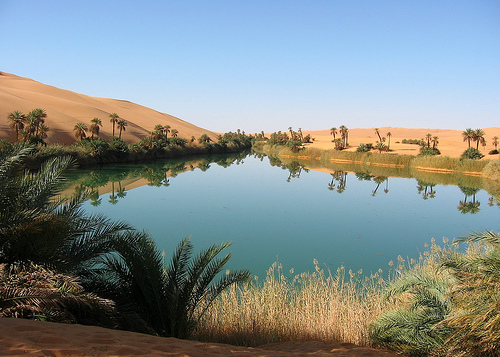If you live in a desert, maintaining a supply of fresh water is a challenge.
如果你生活在沙漠中,保持淡水的供應是個挑戰。
One answer is desalination, but that needs a source of brine from which to remove the salt—
一個答案是海水淡化,但這需要一個鹽水源來去除鹽,
which in turn requires that your desert be near the sea. Even in inland deserts, though, moisture is often present in the air as water vapour.
因此也要求你所在的沙漠靠近大海。即便是在內陸沙漠,空氣中的水分也常常以水蒸氣的形式存在。
The problem is extracting this vapour effectively and cheaply. And that is what two groups of researchers—
問題是如何有效而廉價地提取這些蒸汽。這就是兩組研究人員—
one at the University of Connecticut, the other at the University of California, Berkeley—hope they have managed to do.
一組來自康涅狄格大學,另一組來自伯克利加利福尼亞大學—所希望他們能夠做到的。
The ease with which water can be won from air depends on that air's relative humidity.
從空氣中獲取水分的難易程度取決于空氣的相對濕度。
This is a measure of its current vapour content as a percentage of its maximum possible vapour content at its current temperature.
這是其目前水蒸汽含量的計算方式,作為其在當前溫度下最大可能蒸汽含量的百分比。
A relative humidity of 100% means the air in question is holding as much water vapour as it possibly can.
100%的相對濕度意味著空氣中含有盡可能多的水蒸氣。
A good way to get air to give up some of its moisture is therefore to cool it to the point where its relative humidity exceeds 100%.
因此,讓空氣失去一部分水分的一個好辦法是將其冷卻到相對濕度超過100%的程度。
Sometimes this happens naturally at night, causing mist and dew to form.
有時,夜間會自然發生這種情況,造成霧和露水的形成。
These can be collected in special traps in areas where liquid water is otherwise rare.
在液態水稀少的地區,這些水可以用特殊的捕集器收集。
But if nocturnal cooling does not bring air all the way up to 100% relative humidity,
但如果夜間降溫并不能將空氣的相對濕度提高到100%,

building water traps out of special materials might give nature a helping hand.
那么用特殊材料制造脫水器可能會給大自然帶來幫助。
Adsorption is a process which plucks water molecules from air
吸附是將相對濕度小于100%的空氣中的水分子
that has less than 100% relative humidity by attaching them to the surface of a solid material.
吸附到固體材料表面的過程。
The molecules are held there by electrostatic connections called Van der Waals forces that link them with the molecules of the pertinent surface.
分子通過一種被稱為分子間作用力的靜電連接與相關表面上的分子相連接而固定在那里的。
To collect a lot of water this way therefore requires a material that has two properties.
因此,用這種方法收集水需要一種具備兩種特性的材料。
One is a large surface area. The other is an appropriate Van der Waals response.
一個是很大的表面積。另一個是適當的分子間作用力反應。
Experimental traps that employ this principle have been made using substances called metal-organic frameworks.
利用這一原理的實驗捕集器是用一種叫做金屬-有機骨架的物質制成的。
These are porous molecular networks through which air can circulate. Their porosity gives them a huge surface area.
這些是多孔的分子網絡,空氣可以通過它們循環。它們的多孔性使它們具有很大的表面積。
And by picking the right ingredients, such as zirconium, they can be given the necessary Van der Waals properties. Zirconium is, however, costly.
通過選擇正確的材料,如鋯,它們可以獲得必要的分子間作用力性質。但鋯價格昂貴。
Moreover, once adsorbed, the water must then be released.
而且,一旦被吸附,水就必須被釋放。
This means warming the adsorptive material—the warmth being provided by the sun, once it has risen.
這意味著加熱吸附物質,即太陽升起后提供的熱量。
Here, metal-organic frameworks present a problem. They tend to reflect sunlight rather than absorbing it, and so do not heat up well.
在此,金屬-有機骨架出現了一個問題。它們更傾向于反射而不是吸收陽光,因此不能很好地加熱。
To overcome this, engineers build solid "foams" made of copper into the system.
為了克服這個問題,工程師們在系統中加入了由銅制成的固體“泡沫”。
These heat up in the sun and transfer some of their heat to parts of the adjacent metal-organic framework
它們在太陽下受熱,將一部分熱量傳遞到鄰近的金屬-有機骨架上,
where adsorbed water needs to be released. This works, but adding such foams makes an already costly technology even dearer.
在那里被吸附的水需要被釋放出來。這種方法起了作用,但添加泡沫這種方法讓本就昂貴的技術更加昂貴。
譯文由可可原創,僅供學習交流使用,未經許可請勿轉載。



